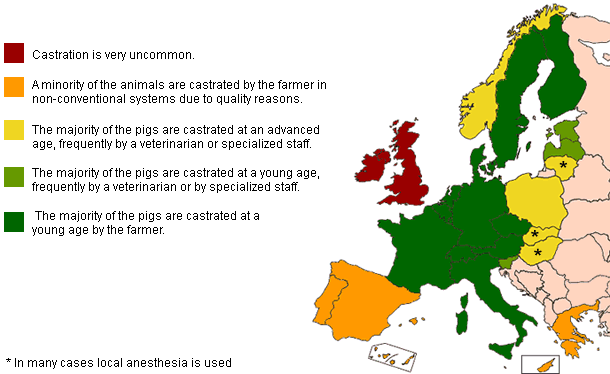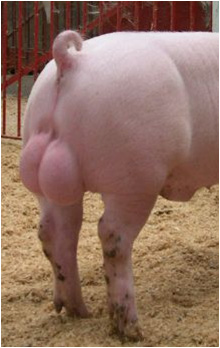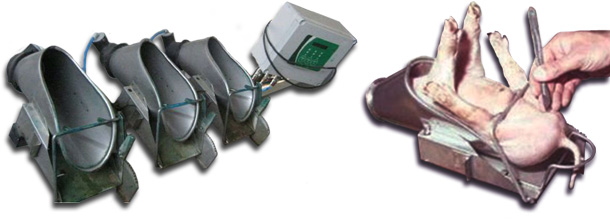1. Current legislative situation
Castration can cause a prolonged pain that is stronger if there is a tearing of tissues. So, these practices are detrimental to the welfare of the pigs, especially when they are performed by incompetent or inexperienced persons. So, rules must be established in order to guarantee better practices.

It is necessary that the official services, the producers, the consumers and others are well informed about the evolution of the sector. According to a report of the Food Safety European Authority, the Committee should follow actively the scientific investigations about the best rearing system or systems in relation to the welfare of the pigs.
Map of the regional variations with regard to the castration of piglets in Europe

Pigcas Project, 2007
The castration of piglets in the European Union is regulated by the Councli Directive 2008/120/EC, of December 18th of 2008, relating to the minimum standards for the protection of pigs (codified version):
 Castration of male pigs:
Castration of male pigs:
The castration of male pigs can be carried out by means that do not imply the tearing of tissues under the following conditions:
- In the case of those piglets below the age of seven days, the castration will only be performed by a veterinarian or by a person that has been trained in animal welfare and that has experience in the carrying out of these techniques with adequate means and hygienic conditions.
- In the case of those piglets from their seventh day of age or older, the castration will only be performed, under anaesthesia and a prolonged analgesia, by a veterinarian.
2. European Declaration on alternatives to the castration of pigs
After the report written by the Food Safety European Authority declaring that the castration before the seventh day of age is painful, and recommending a checking of the regulations, there has been a debate about the banning of the castration of piglets in the European Union.
Due to this debate, a European Declaration on alternatives to the castration of pigs has been signed. This declaration is a voluntary agreement in which, for the first time, the European swine farmers have expressed a proactive stance with the aim of presenting a solution, from the swine sector, to a social demand.
In the aforementioned declaration it has been shown that the surgical castration of the pigs poses an animal welfare concern. Castration is performed in order to avoid the development of unwanted sexual or aggression behaviours, and to avoid the appearance of boar taint, because the flavour and the odour that the meat will have is a very important factor when the consumer makes decisions when buying meat. Castration is not a decision of the farmer, but an election caused by the market.

| Inhalational anaesthesia machine for piglets | Castration of a piglet |
In accordance with this commitment, the producers, abattoirs and meat industries, veterinarians, NGOs and other actors in the chain have established two dates for the ending of the surgical castration:
The first step has been taken on January 1st 2012. If those who have voluntarily made use of this declaration carry out a surgical castration on pigs, they will do it with anaesthesia and/or prolonged analgesia and according to the mutually approved methods. According to this first step, we can produce entire males, immunocastrated males, males castrated with anaesthesia and prolonged analgesia, males castrated with anaesthesia or males castrated with prolonged analgesia.

The second step of the declaration will be taken on January 1st 2018, which states that the surgical castration of pigs should be abandoned.
In order to guarantee the disappearance of the surgical castration, the following elements will be available and applicable:
- Mutually agreed methods for the evaluation of the boar taint.
- Reference methods recognized in Europe for the measurement of all the compounds that are responsible for the boar taint.
- Methods for the quick detection of the boar taint in the abattoirs.
- Reduction of the compounds that cause the boar taint by means of practices related to the selection, the management and the feeding of the pigs.
- Production and management systems of the entire males during their rearing, transportation and slaughter oriented towards the minimizing of the sexual and aggressive behaviours.
We must bear in mind that in this declaration there are some exceptions: they are the production systems whose meat gives place to "Traditional Specialities Guaranteed" or "Protected Geographical Indications" or the "Protected Designations of Origin" or the pig meat used for the production of high quality traditional products in which castration is unavoidable.
3. Alternatives to the surgical castration without anaesthesia or analgesia
The options that can be considered as alternatives to the surgical castration without anaesthesia are as follows:
| Method | Strengths | Weaknesses |
| Surgical castration with anaesthesia |
The implementation is quick. There are devices. It eliminates aggressive behaviours in the fattening-finishing stage. 100% effective for the reduction of the sexual odour. |
Weak support on the NGOs' part. Expensive (product and time). No reduction of the post-surgical pain. Danger due to the handling of the gas. |
| Surgical castration with prolonged analgesia |
The implementation is quick. There are devices. It eliminates aggressive behaviours in the fattening-finishing stage. 100% effective for the reduction of the sexual odour. |
Weak support on the NGOs' part. It is difficult to demostrate that the surgical pain is avoided. |
| Surgical castration with anaesthesia and prolonged analgesia |
The implementation is quick. There are devices. It reduces the pain due to the castration. It eliminates aggressive behaviours in the fattening-finishing stage. 100% effective for the reduction of the sexual odour. |
Weak support on the NGOs' part. Expensive (product and time). Danger due to the handling of the gas. |
| Immunocastration |
Its implementation is quick. It does not need a special equipment. The pain and the discomfort of the castration are eliminated. Elimination of the sexual odour. Until the 2nd dose the animal behaves as an entire pig (IC). |
2 injections are necessary. Until the 2nd dose the animal behaves as an entire animal (aggressiveness). Risk due to the worker suffering a possible self-injection. |
| Entire (non-castrated) animals production |
Castration is avoided. Better value of the meat. Better yields (CI). Strong support on the NGOs' part. |
Weak support on the part of the industry branch. |
| Semen sexing |
Production of females. It would not be necessary to castrate. |
This technique is not well-developed and it is expensive. Not in the short term. Sexual odour in the females? Sexing in order to produce males or females? |
| Genetic selection |
Linked to the production of entire males. Definitive solution. |
This technique is not well developed and it is expensive. Not in the short term. Sexual odour in the females? Sexing in order to produce males or females? |



